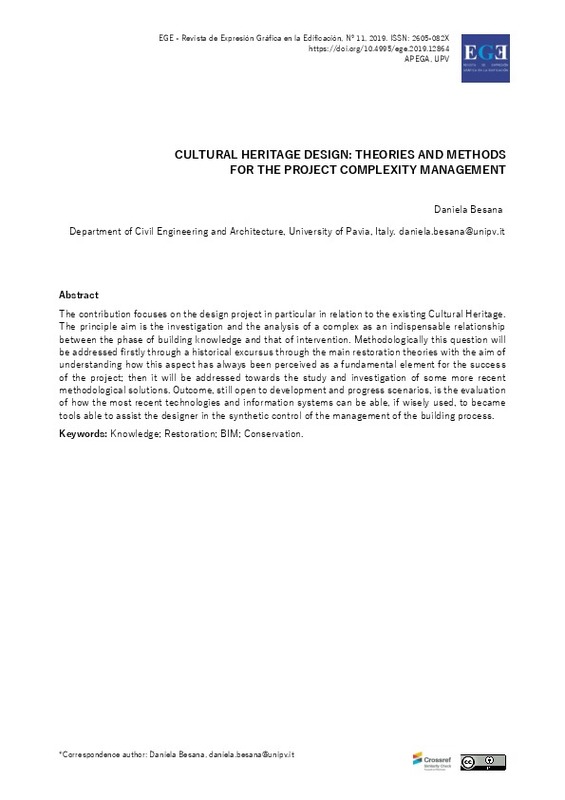JavaScript is disabled for your browser. Some features of this site may not work without it.
Buscar en RiuNet
Listar
Mi cuenta
Estadísticas
Ayuda RiuNet
Admin. UPV
Cultural heritage design: theories and methods for the project complexity management
Mostrar el registro sencillo del ítem
Ficheros en el ítem
| dc.contributor.author | Besana, Daniela
|
es_ES |
| dc.date.accessioned | 2020-05-05T11:23:06Z | |
| dc.date.available | 2020-05-05T11:23:06Z | |
| dc.date.issued | 2019-12-30 | |
| dc.identifier.issn | 1888-8143 | |
| dc.identifier.uri | http://hdl.handle.net/10251/142361 | |
| dc.description.abstract | [EN] The contribution focuses on the design project in particular in relation to the existing Cultural Heritage. The principle aim is the investigation and the analysis of a complex as an indispensable relationship between the phase of building knowledge and that of intervention. Methodologically this question will be addressed firstly through a historical excursus through the main restoration theories with the aim of understanding how this aspect has always been perceived as a fundamental element for the success of the project; then it will be addressed towards the study and investigation of some more recent methodological solutions. Outcome, still open to development and progress scenarios, is the evaluation of how the most recent technologies and information systems can be able, if wisely used, to became tools able to assist the designer in the synthetic control of the management of the building process. | es_ES |
| dc.description.abstract | [ES] The contribution focuses on the design project in particular in relation to the existing Cultural Heritage. The principle aim is the investigation and the analysis of a complex as an indispensable relationship between the phase of building knowledge and that of intervention. Methodologically this question will be addressed firstly through a historical excursus through the main restoration theories with the aim of understanding how this aspect has always been perceived as a fundamental element for the success of the project; then it will be addressed towards the study and investigation of some more recent methodological solutions. Outcome, still open to development and progress scenarios, is the evaluation of how the most recent technologies and information systems can be able, if wisely used, to became tools able to assist the designer in the synthetic control of the management of the building process. | es_ES |
| dc.language | Inglés | es_ES |
| dc.publisher | Universitat Politècnica de València | |
| dc.relation.ispartof | EGE Revista de Expresión Gráfica en la Edificación | |
| dc.rights | Reconocimiento (by) | es_ES |
| dc.subject | Knowledge | es_ES |
| dc.subject | Restoration | es_ES |
| dc.subject | BIM | es_ES |
| dc.subject | Conservation | es_ES |
| dc.title | Cultural heritage design: theories and methods for the project complexity management | es_ES |
| dc.type | Artículo | |
| dc.identifier.doi | 10.4995/ege.2019.12864 | |
| dc.rights.accessRights | Abierto | es_ES |
| dc.description.bibliographicCitation | Besana, D. (2019). Cultural heritage design: theories and methods for the project complexity management. EGE Revista de Expresión Gráfica en la Edificación. https://doi.org/10.4995/ege.2019.12864 | es_ES |
| dc.description.accrualMethod | OJS | es_ES |
| dc.type.version | info:eu-repo/semantics/publishedVersion | es_ES |
| dc.identifier.eissn | 2605-082X | |
| dc.relation.pasarela | OJS\12864 | es_ES |








